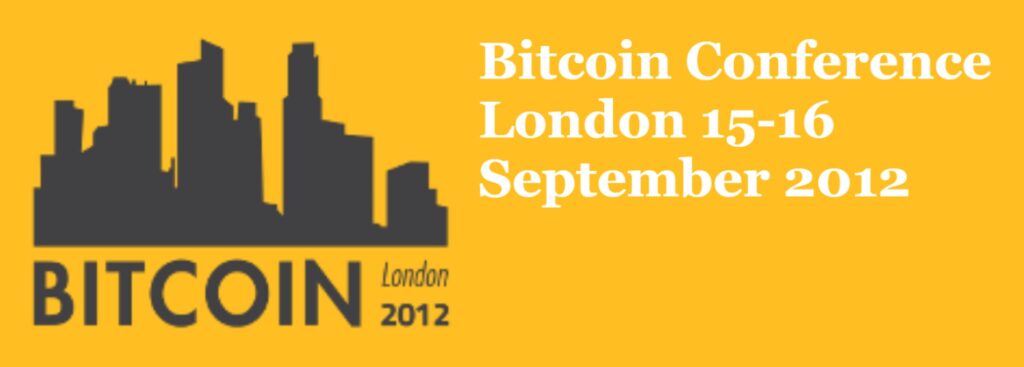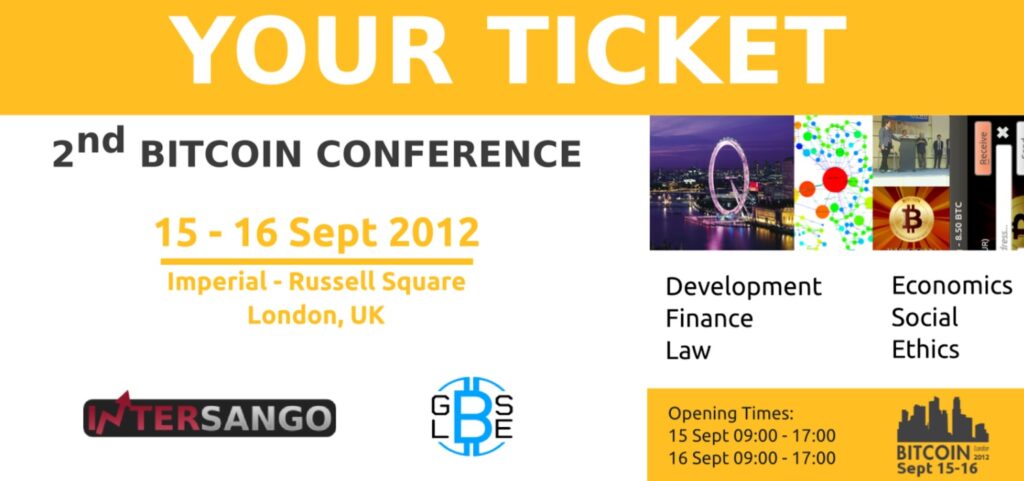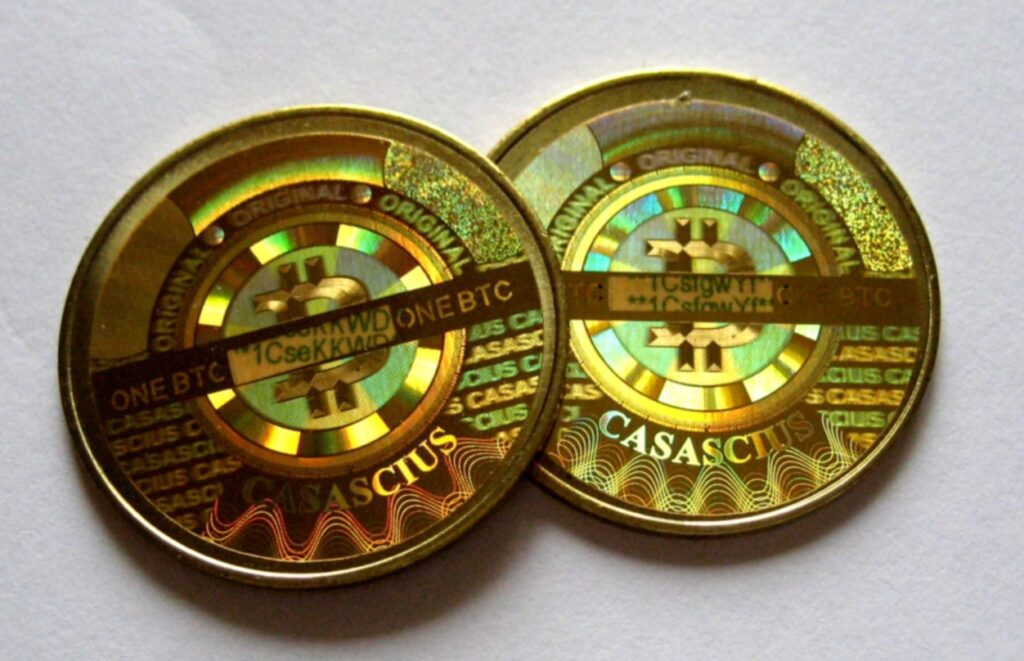Abstract: In this nostalgic look back into Bitcoin’s history, we go back over eight years, to the London Bitcoin Conference of 2012. This report summarises the talks of the main speakers and tries to capture the radical anti-establishment political viewpoint which was dominant in the Bitcoin community at the time. We also describe some early precursors to technologies such as smart contracts and distributed exchanges, the main development priorities back then, plus the upbeat message given in the 2012 “State of the Coin” address.

Overview
In this piece we review the London 2012 Bitcoin Conference, held at Imperial (Russell Square) on the 15th and 16th of September 2012. The primary conference organiser was Amir Taaki (Genjix), perhaps the largest personality and thought leader in the space at the time. It was the first major Bitcoin conference this author attended and the second major conference ever, following the Prague conference in 2011, which many of the attendees had been to. Up until this point my engagement with the Bitcoin community had either been via the internet or one-on-one meetings, therefore this conference was a new and exciting experience. To date, this event was by far the most interesting cryptocurrency conference I have ever attended and I believe this report may provide a useful insight into the culture of the space at the time.
The tickets to the event cost £50, you could either pay cash on the door or in advance with bitcoin. “Cash on the door”, sounded outrageous to me! If you did not spend your bitcoin when going to a Bitcoin conference, when would you ever spend it? Therefore I sent eight bitcoin to the organisers and purchased my ticket.

This report is based largely from memory, as well as a few notes I took at the time and therefore it is likely to contain some inaccuracies. A few of the speeches are up on YouTube, and where these are available, I have provided the references.
Speakers
Jeff Garzik & Pieter Wuille (State of the Coin Address)
The most interesting speech at the event was given jointly by Jeff Garzik and Pieter Wuille. Entitled “State of the Coin 2012”, it provided insight into network statistics and the technical development outlook. This was the only talk on which I produced extensive notes. Most of the other speakers at the event were interested in Bitcoin, but often from a particular angle: radicalism, anarcho capitalism, or a general interest in distributed computer networks. Pieter and Jeff were clearly both deep into the weeds of Bitcoin at this point, working on what was then called the “reference client”, or even just Bitcoin. I remember Pieter introducing himself in an extremely modest fashion, as someone who worked for, and was introduced to Bitcoin by, Mike Hearn at Google (a speaker from the previous day).
The presentation started by explaining the challenges of Bitcoin development, using the analogy of trying to fix and upgrade an airplane while it was flying at 300mph through a storm. Pieter and Jeff then went into detail about some of the key software improvements they were working on, including:
- P2SH
- Making blocks download faster
- Stronger P2P network
- IPv6 and Tor support
- New user interface
- Improving transaction fees
- Adding support to sign messages with private keys
- Importing private keys
- Raw transaction RPC API
- P2pool support
They went on to provide some statistics, which demonstrated strong growth and the healthy state of the Bitcoin network.
Network power
| 2009 | 0.01 Ghash/sec |
| 2010 | 103 Ghash/sec |
| 2011 | 8,000 Ghash/sec |
| 2012 | 19,000 Ghash/sec |
Number of transactions
| 2009 | 219 |
| 2010 | 100,000 |
| 2011 | 2,000,000 |
| 2012 | 5,000,000 |
Bitcoin price
| 2009 | $0.03 |
| 2010 | $0.3 |
| 2011 | $5.0 |
| 2012 | $10.0 |
The next positive comment was mentioning that Deepbit no longer had a hashrate share of greater than 50 percent, evidence that the network was maturing and becoming more distributed. Despite these positive statistics, the tone was somewhat moderate and cautious, with both speakers warning the system was highly experimental and risky.
Do not put your life savings into Bitcoin
(Source: Pieter Wuille and Jeff Garzik – Bitcoin London 2012)
Mike Hearn (Developer)
Perhaps the most well articulated speech was from Mike Hearn, packed with many exciting ideas looking years ahead in an intensive 30 minute session. Mike explained the mechanics of smart contracts, smart property, assurance contracts, p2p decentralised bond markets, p2p decentralised exchanges, and p2p decentralised investment funds. The ideas mentioned were a precursor to many of the technologies and systems we have seen develop in this space over the last few years. Some of these failed miserably due to fundamental flaws, while others are still being worked on and some are only recently beginning to gain traction and see some success. For example Ethereum (Smart contracts), Slockit (Smart property), Uniswap (p2p decentralised exchanges) and The DAO (p2p decentralised investment funds). Having the foresight to envision so many of these ideas, many of which are precursors to the technologies and systems that eventuated, at such an early stage is clearly impressive. At the time, Mike’s speech went down extremely well, as I recall.
It was clear to me that Mike saw certain things differently to Amir and some of the members of the community that saw themselves, as Amir did, as “true radicals”, or anti-establishment anarcho capitalists. Mike appeared to sympathise with the disintermediation and decentralisation aspects of these political visions, but it was clear to me his style was very different to Amir. I did detect a small amount of tension between the two of them and their respective approaches, but this was definitely not something that was a major feature or takeaway from the conference.
Just over three years later, in January 2016, Mike Hearn announced he was quitting Bitcoin, in his famous “The resolution of the Bitcoin Experiment” article, for issues mainly related to the blocksize war. At the time, the “true radical” Amir wasn’t involved in Bitcoin – instead, he was fighting with Kurdish militia forces in Syrian Kurdistan.
Mike’s 2012 talk is available on YouTube
Max Keiser (Financial Pundit)
Russia Today TV presenter and financial journalist Max Keiser was one of the star attractions of the conference. Max did not appear deep into the technical side of Bitcoin and instead his speech provided context to the financial landscape and macroeconomic environment in which Bitcoin existed in, which he considerd highly favourable for Bitcoin. He repeated many of the anti-bank, anti-establishment themes found on his TV show, lambasting several high profile bankers such as Jon Corzine and Jamie Dimon for a litany of offenses such as re-hypothecation, “negative reserve banking”, front running, money laundering, and fraud. When Max started talking about Bitcoin, he mentioned that PayPal censored his “Pirate My Film” website, because it had “pirate” in the name, which prompted him to adopt Bitcoin as the only payment method.
Max’s 2012 talk is available on YouTube
Richard Stallman (Free Software Advocate)
The keynote speaker was free software advocate Richard Stallman. Richard came across as an outsider to the Bitcoin community, and like Max was very much providing the context to Bitcoin from his area of expertise. In his case he talked about digital rights, free software, digital privacy, and electronic surveillance.
Richard’s 2012 talk is available on YouTube
Birgitta Jonsdottir (Pirate Party)
Another speaker of note was Birgitta Jonsdottir, an anarchist and MP for the Pirate Party in Iceland, which she co-founded. Like Max and Richard, she wasn’t a Bitcoin expert, but had an anti-establishment political ideology which was shared by many in the community. She talked about Julian Assage (whom she had met in Iceland a couple of years earlier) and WikiLeaks.
Cody Wilson (3D Printed Gun)
Another self-proclaimed radical who spoke at the event was Cody Wilson. Cody spoke about his project to produce an open source 3D printed gun, a project which was only two months old by then. Despite the anarchist nature of the audience, I remember Cody being asked quite challenging philosophical questions about his idea, such as where to draw the line on distributing potentially dangerous technologies.
In 2015 Cody unsuccessfully ran for a seat on the board of the Bitcoin Foundation, with his key election message being that he wanted to destroy the foundation, since in his view Bitcoin did not require such an organisation. In 2018 Cody was arrested in Taiwan for a sexual assault offence he allegedly commited in Texas and was eventually extradited to the US.
Cody’s 2012 talk is available on YouTube
James McCarthy (GBLSE)
The only other talk I remember well is a speech by James McCarthy (Nefario) on the Global Bitcoin Stock Exchange (GBLSE). This platform could probably be the subject of another full report. GBLSE was essentially a capital market for shares and bonds, where people could raise funds for their projects in Bitcoin in exchange for shares. James explained that the advantages of his platform, where that issuers could potentially have real world anonymity and issuance costs would be much lower. For example, people could raise a few hundred pounds rather than millions on the major stock exchanges. He also explained that Bitcoin needed capital markets and other financial infrastructure in order to succeed. At the time GBLSE was performing extremely well, right at the peak of its major growth cycle, averaging millions of dollars of trading volume per day. James estimated that around one third of the Butterfly Labs prepayments, likely to total around $10 million in my view, were funded through offerings on GBLSE.
Our experience has been that anonymous people selling shares hasn’t turned out very well
(Source: James McCarthy – Bitcoin London 2012)
James set this up initially as a hobby and did not take it too seriously, so the platform lacked the robust infrastructure necessary to succeed, in my view. James mentioned that someone set up a cannabis farm asset on the platform during the weekend while he was away, which started to trade, when he got back he had to shut down the asset, due to fear of a regulatory crackdown. He mentioned that it would be great if a fully anonymous dark capital market place could exist, where people could raise funds for anything, something which excited the audience.
Needless to say, in my view, most of the projects which listed on the platform were scams or Ponzi schemes and many investors lost money, such that the platform eventually had to shut down.
James’s 2012 talk is available on YouTube
Casascius physical bitcoins
Outside of the main speaking room there were a few booths, basically three or four tables with various items on display. I remember there was a table with an experimental Avalon ASIC miner on display. A giant device, which looked like it weighed over 30 kilograms, the device was not yet available for sale and was in the pre-mass production stage. It was later sold off in an auction at the event.
By far the most popular table was Mike Caldwell’s. He was selling his Casascius physical Bitcoins. On the desk were stacks of the coins in different denominations, 1 BTC, 2 BTC, 10 BTC, 100 BTC and even some larger denomination coins into the thousands. From what I observed, Mike appeared to have an excellent couple of days, selling many units of his stock for cash.

Conclusion
The key takeaways I had from the event was that the participants there were intelligent, extremely excited, and optimistic about Bitcoin. However, participants did seem sufficiently skeptical about Bitcoin and asked each other very challenging and pertinent questions, which I found impressive. There was genuine debate there about politics, economics, mathematics, cryptography, finance, digital privacy, and computer science. Most people seemed curious and open minded, the place was far less cultish and delusional than I had expected. Nobody at that point appeared to think Bitcoin’s success was inevitable – instead most people were just extremely curious and intrigued by it.
In general, conference participants appeared to have a lot of sympathy for the idea that the political economic system was corrupt and the most effective path forward was to either help ensure the collapse of the system or to ensure that the establishment systems became less relevant by bypassing them and using alternative systems. Bitcoin was seen as a tool, alongside other technologies such as Tor, WikiLeaks, Bittorrent, and alternative DNS systems, to help achieve this objective.
After the event, I remember thinking that I should probably buy more Bitcoin. However, it did seem quite expensive at the time, at over $10. I decided it might be better to wait for a better buying opportunity before investing more.
